Sarah Albee's Blog, page 4
September 19, 2016
Chappaqua Book Festival
 This Saturday, September 24th, I’ll be joining a whole host of authors and illustrators at the Chappaqua (NY) Book Festival. It’s my first year attending, and I have heard that it’s one of the best festivals in the country. I hope you’ll consider coming if you live nearby–and please stop by my table to say hello! Details here.
This Saturday, September 24th, I’ll be joining a whole host of authors and illustrators at the Chappaqua (NY) Book Festival. It’s my first year attending, and I have heard that it’s one of the best festivals in the country. I hope you’ll consider coming if you live nearby–and please stop by my table to say hello! Details here.
The post Chappaqua Book Festival appeared first on Sarah Albee.
August 10, 2016
New and Improved Website Coming Soon!
 Loyal readers will notice that I haven’t posted in awhile. My web designer and I are working on updating and improving my site, and hope to have it ready by the end of August. Have a wonderful summer in the meantime, all!
Loyal readers will notice that I haven’t posted in awhile. My web designer and I are working on updating and improving my site, and hope to have it ready by the end of August. Have a wonderful summer in the meantime, all!
The post New and Improved Website Coming Soon! appeared first on Sarah Albee.
July 18, 2016
The Schuylers
 Last week I drove to upstate New York for my annual writing retreat. On the way, I stopped off at the Schuyler Mansion in Albany. Philip Schuyler and his wife, Catharine van Rensselaer, lived in this house with their eight children. (They had a set of twins and a set of triplets that did not survive.) The eldest surviving child was Angelica. Another daughter, Eliza, married Alexander Hamilton. I’m researching Hamilton for an upcoming project. Have I mentioned I have the best job in the world?
Last week I drove to upstate New York for my annual writing retreat. On the way, I stopped off at the Schuyler Mansion in Albany. Philip Schuyler and his wife, Catharine van Rensselaer, lived in this house with their eight children. (They had a set of twins and a set of triplets that did not survive.) The eldest surviving child was Angelica. Another daughter, Eliza, married Alexander Hamilton. I’m researching Hamilton for an upcoming project. Have I mentioned I have the best job in the world?
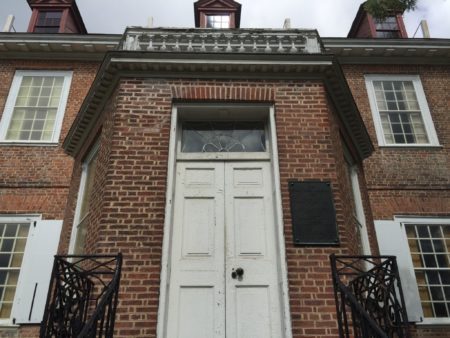
The house is built on a steep slope, so it was hard to get a good shot of the front.
There were only seven of us on the tour—me, a couple from Saratoga, and a family of four with two charismatic kids. The boy knew a lot about Revolutionary war battles, and the girl seemed interested in everything, which was a good thing, because I may or may not have co-opted the tour. Danielle, our tour guide, was wonderful and knowledgeable, but I always feel bad for tour guides when a writer, for instance, me, shows up for a tour. Obviously I didn’t feel bad enough, because I pestered Danielle with questions.
Unfortunately all the most interesting stuff (to me) about the house has not survived—namely, the slave quarters, the kitchen, and the necessary. But Danielle knew a lot about them, and answered my questions. And it was exciting to see the original portraits of Eliza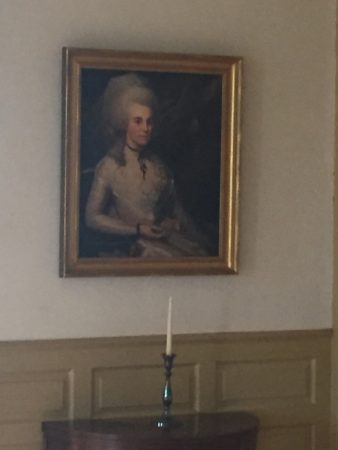
And Angelica (here she is with one of her ten children): It was cool to see field beds that can be broken down for travel, along with a bed key:
It was cool to see field beds that can be broken down for travel, along with a bed key: Danielle obligingly held up a jar of leeches from Philip’s medical kit, so I could photograph it.
Danielle obligingly held up a jar of leeches from Philip’s medical kit, so I could photograph it.
 And here’s what may or may not be a cut from a sword or tomahawk on the banister.
And here’s what may or may not be a cut from a sword or tomahawk on the banister.  In 1781, a band of British soldiers and local loyalists, operating out of Canada, attempted to kidnap Philip Schuyler. In one version of the story, which Danielle says is difficult to verify, Peggy had just grabbed her baby sister Catharine from the cradle, en route to fleeing upstairs with her, when someone threw a tomahawk at her and missed.
In 1781, a band of British soldiers and local loyalists, operating out of Canada, attempted to kidnap Philip Schuyler. In one version of the story, which Danielle says is difficult to verify, Peggy had just grabbed her baby sister Catharine from the cradle, en route to fleeing upstairs with her, when someone threw a tomahawk at her and missed.
Here’s another version of the thwarted kidnap attempt, which doesn’t include the dramatic last-minute rescue of a baby, but is still pretty exciting.
The post The Schuylers appeared first on Sarah Albee.
July 9, 2016
Behind the Curtain

Jan Steen, Morning Toilet, 1663
Have you ever heard of a “curtain lecture?” (The above image isn’t actually a curtain lecture. I just liked the image.)
A “curtain lecture” (sometimes called a “bolster lecture”) is a private reprimand given by a wife to her husband. Back in the days when a bed was often a family’s most valuable possession, many were four-poster types with thick curtains. The curtains kept away drafts, and also, according to generations of male writers, allowed the wife to scold her husband in privacy.
I actually stopped at this reference and wondered about it when I recently read Dicken’s Our Mutual Friend:
‘You are just in time, sir,’ said Bella; ‘I am going to give you your first curtain lecture.’
A search for the term in literature calls up dozens of examples, and they go way back. Here’s one from 1640, in the the book Ar’t Asleepe Husband? A Boulster Lecture by Richard Brathwait. Brathwait is going for levity. A wife’s admonitions, he assures the reader, are meant to be dismissed as random background noise :
This wife a wondrous racket meanes to keepe,
While th’Husband seems to sleepe but do’es not sleepe:
But she might full as well her Lecture smother,
For ent’ring one Eare, it goes out at t’other.*
Ha ha LOL. And here are some images of curtain lectures, all of course rendered by male artists.
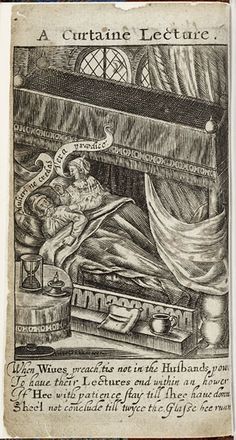
From Thomas Heywood’s A Curtaine Lecture, 1637 The text says: When wives preach, tis not in the Husbands power to have their lectures end within an hower. If Hee with patience stay till shee have donn. Shee’l not conclude till twyce the glass Hee runn.
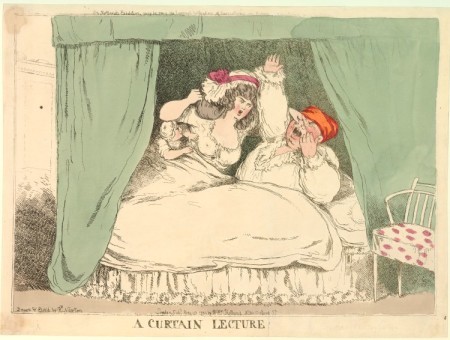
1794 (British Museum)
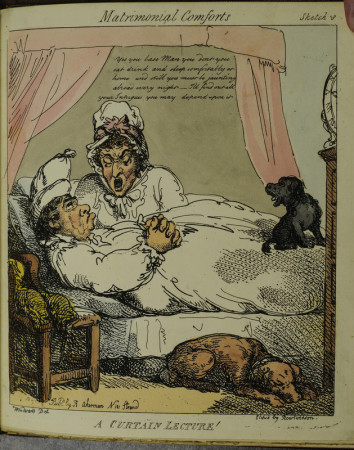
1799 (Lewis Walpole Library)
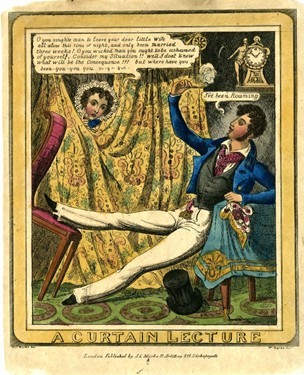
1824 (British Museum)
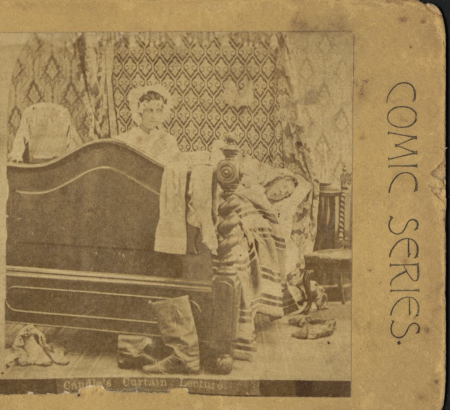
late 19th century via Boston Public Library
*As quoted in Sloan, LaRue Love, “I’ll watch him tame, and talk him out of patience”: The Curtain Lecture in Shakespeare’s Othello. Lamb, Mary Ellen, Bamford, Karen, eds. Oral Traditions and Gender in Early Modern Literary Texts. Burlington, VT: Ashgate, Publishing, 2008, p 88.
The post Behind the Curtain appeared first on Sarah Albee.
June 30, 2016
Author Event
 Connecticut friends: if you are anywhere near Guilford (near New Haven) next Wednesday, July 6th, please drop by the library for this super-fun—and free!–event:
Connecticut friends: if you are anywhere near Guilford (near New Haven) next Wednesday, July 6th, please drop by the library for this super-fun—and free!–event:
Details: Join ten local middle grade and young adult authors–Sarah Albee, Hannah Barnaby, Ace Bauer, Leslie Bulion, Leslie Connor, Sarah Darer, Page McBrier, Adam Shaughnessy, Cat Urbain, and Sandra Waugh–for a celebration of summer reading featuring games, snacks, book talks, and author signings! Drop in whenever you can and stay as long as you like. Hosted by the Guilford Free Library. Book sales provided by Breakwater Books.
Address: 67 Park St, Guilford, Connecticut
Hope to see you there!
The post Author Event appeared first on Sarah Albee.
June 22, 2016
Theodosia and Theodosia

A young Aaron Burr
Fans of the Broadway show, Hamilton, will be familiar with the beautiful duet, Dear Theodosia, sung by Aaron Burr (Leslie Odom Jr.) and Alexander Hamilton (Lin-Manuel Miranda). It’s an ode to their newborn babies, Theodosia and Philip. (You can listen to it here.)
Earlier in the play, in the Story of Tonight reprise, Burr had confessed to Hamilton that he’d been having an affair with the wife of a British officer. That would be Theodosia’s mother, Theodosia. Let’s investigate the history behind this:
During the war, Aaron Burr was the aide-de-camp to General Israel Putnam, Washington’s second in command. Putnam had been a hero of the July 1775 Battle of Bunker Hill, and was now in charge of Long Island. It was probably while he was stationed in New Jersey, in 1777, that Burr met Theodosia Prevost (pronounced “pree-VOH.” Her husband was of Swiss-German origin). Her husband was off fighting in the southern colonies. But she herself was a patriot, siding with Washington and the Americans. Ten years older than Burr, she had married at seventeen, and had five children. She was also sick, probably with stomach cancer.
The show Hamilton is not kind to Burr, with justification. Among his other flaws, he was certainly a womanizer. But he was also extremely progressive for his time on the subject of a woman’s capacity for genius, and he fell hard for the witty and highly-educated Mrs. Prevost. And she for him. By all accounts, she was a top-notch intellect and charmer. It’s unclear exactly when their love affair began.
In December 1781, she learned that her husband, stationed in Jamaica, had died of yellow fever. She and Burr were free to marry, and did so in July of 1782. In 1783 they had a daughter, who, at Burr’s insistence, they named Theodosia. The war ended in 1783. In 1785 they had a second daughter, Sally, but she died at age three. Theodosia would be the only child of Burr’s who would reach adulthood.
He was a big fan of Mary Wollstonecraft’s A Vindication of the Rights of Woman, published in 1792, and he raised his daughter as a thoroughly educated woman of the Enlightenment. As Theodosia, his wife, grew sicker, Burr took over more and more responsibility for his daughter’s education. Theodosia-the-wife died at age 48.
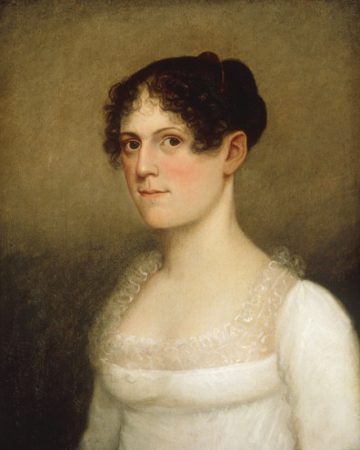
Theodosia Burr Alston
Theodosia-the-daughter married a boring rich guy named Joseph Alston at age seventeen, and they had a son, whom they named Aaron Burr Alston. Sadly, he died at age eleven. A year later, in 1812, the still-grieving Theodosia set out to visit her father. The United States had just declared war against Great Britain, and Theodosia’s husband was in command of a militia in South Carolina, so he couldn’t accompany her. In December of 1812 she left Charleston on a schooner bound for New York, with only her maid and a male escort. There was a violent storm off the coast of the Carolinas, and the ship was lost at sea. She was just thirty years old.
Source: Nancy Isenberg, Fallen Founder: The Life of Aaron Burr
The post Theodosia and Theodosia appeared first on Sarah Albee.
June 14, 2016
Mate and Create

Gray Wolf
Photo: Gary Kramer, USFWS, Creative Commons
A classic favorite movie in our house is Napoleon Dynamite, and here’s one of our favorite scenes:his drawing of a “liger.”
But were you aware that ligers really exist?
My friend Laura is one of my go-to scientists. She not only teaches AP Biology, but also POST-AP Biology, for high school seniors who can’t get enough Biology. Kids flock to take her classes. I ask her for help on pretty much all my books. (Here’s a post I did about inbred monarchs, with Laura’s help.)
So at dinner the other night, I asked her to help me define “species” for my dog book. Dogs are a subspecies of wolf, but I was getting all balled up trying to define that. It used to be so simple. A species used to be defined as similar organisms that could mate and produce fertile offspring.
But Laura explained that sometimes the barriers to reproduction to two species can be removed when habitat conditions change. “Species,” then, can be context specific. If the context changes, then two species can hybridize and become one.
For instance, explained Laura, take Lake Victoria cichlids. “Changes in light conditions due to pollution mean that two species of the genus pundamilia will mate when before they wouldn’t. Females pick mates based on their color. So in the polluted water, the females can’t tell the difference between the two species of male and will mate with either. The hybrid babies are just as fit (in the evolutionary sense–they are just as able to have babies) as mom and dad, so scientists think the two species will fuse back into one.”
In case you’re wondering, she’s talking about a genus of fish. (I had to look that up.)
What does this have to do with ligers? Well in part due to global warming, a major barrier to reproduction has been removed. Polar bears’ habitat is vanishing, so they’re moving south and mating with grizzly bears. So now there are:
Grolar Bears

Polar/Brown Bear adult hybrid. Rothschild Museum, Tring, England.
Sarah Hartwell (Messybeast) via Wikimedia Creative Commons Share-Alike
And whales and dolphins have mated and created:
Wolphins.

Second-generation wolphin female “Kawili Kai” (*23 December 2004) at Sea Life Park Hawaii, 9 months old. Offspring of first-generation wolphin female “Kekaimalu”
Photo by Mark Interrante via Wikimedia Creative Commons Share-Alike
And yes, lions and tigers have mated and created:
Ligers

Photo of male and female ligers (a liger is a cross-breed of a male lion and a female tiger) taken at Everland amusement park, South Korea.
Photo by Hkandy via Wikimedia Creative Commons Share-Alike
Here’s Laura in class, getting a surprise visit from her son, Matt, who is a “uniman.” Did I mention Laura is married to a unicorn?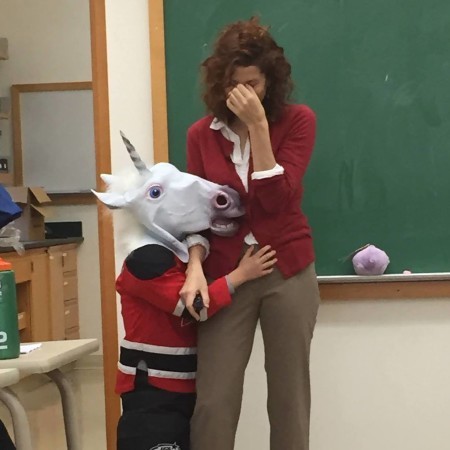
The post Mate and Create appeared first on Sarah Albee.
June 8, 2016
That’s Harsh
 I try not to discuss politics on this blog, but the widespread criticism of Hillary Clinton’s “annoying” voice begs for some historical context. The criticism tends not to be about what she is saying–it’s about how she’s saying it. You may disagree with her, or with Trump, or with Sanders. But of the three canditates, why is it Hillary’s voice that gets criticized so often?
I try not to discuss politics on this blog, but the widespread criticism of Hillary Clinton’s “annoying” voice begs for some historical context. The criticism tends not to be about what she is saying–it’s about how she’s saying it. You may disagree with her, or with Trump, or with Sanders. But of the three canditates, why is it Hillary’s voice that gets criticized so often?
A lot of commentators and news reporters comment on it. Many complain that she is loud, or shrill, or inauthentic.
Then there’s this article in the Daily Mail, which pretends to be discussing the voices of “powerful people” and how their voices grow more monotonous and higher-pitched as they get more power. But the only two “powerful people” the article discusses by name are women–Thatcher and Clinton.
Let’s go back in time–to the year 60 AD. The warrior queen of Celtic Britain, Boudica (sometimes spelled Boadicea) led a bloody rebellion against the Roman occupying forces. Roman historians were notoriously misogynistic. Cassius Dio described her as very tall (“in appearance almost terrifying”). And “a great mass of the tawniest hair fell to her hips.” But get this: “and her voice was harsh.” As Boudica’s modern biographer Antonia Fraser put it, “Condemnation of a female leader very often throws in the fact that her voice is harsh or strident.”
![By Rafesmar (Own work) [CC BY-SA 3.0 (http://creativecommons.org/licenses/by-sa/3.0)], via Wikimedia Commons](https://i.gr-assets.com/images/S/compressed.photo.goodreads.com/hostedimages/1465393891i/19350457.jpg)
By Rafesmar (Own work) [CC BY-SA 3.0 (http://creativecommons.org/licenses/b...)], via Wikimedia Commons
Cassius Dio, Roman History
Antonia Fraser, The Warrior Queens, NY: Knopf 1989, p 60 (library book)
The post That’s Harsh appeared first on Sarah Albee.
June 2, 2016
Knockdown, Drag-Along
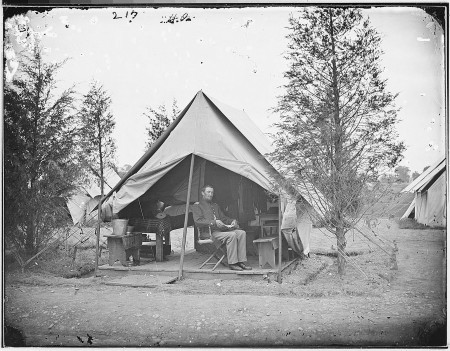 It’s been a long time since I was in high school, but I’m still in touch with my favorite teacher—who taught history, naturally—Mr. Heller. (It took me about twenty five more years to call him by his first name, Miles.) Anyway he read my blog from last week about portable writing desks and messaged me:
It’s been a long time since I was in high school, but I’m still in touch with my favorite teacher—who taught history, naturally—Mr. Heller. (It took me about twenty five more years to call him by his first name, Miles.) Anyway he read my blog from last week about portable writing desks and messaged me:
Did you ever hear of campaign furniture?
In the Am Revolution, they carried huge collapsible furniture, like chests, tables etc. with arms on them so that they could be carried. Sometime, they had to cut trees down to get the stuff through. . . . Look it up. It is pretty interesting. I can’t imagine being one of the guys who had to carry things like wardrobes.
So of course I looked it up, and it’s fascinating. Campaign furniture was specially designed to be assembled and disassembled, and was made for wealthy officers to take along with them when they went to war. Officers of the eighteenth and nineteenth centuries did not pack light. They brought along dressers, dining room tables, and elegantly upholstered seating. Some even brought canopied beds. The campaign furniture varied from simple to quite ornate, and was often ingeniously designed.
In 1782, General Washington wrote to his Quartermaster, Timothy Pickering, about whether horse or ox teams ought to pull the column of officers’ baggage:
General Officers should be accommodated with Horse Teams than others, as they may frequently have occasion to make more expedition in their movements than other Officers; whereas the Baggage of the Officers of the Staff and the Line will rarely if ever be separated [sic] from the column of Baggage, on a march…

Outdoor scene of George Washington in a military encampment. (MountVernon.org)
Also known as “knockdown” furniture, the trend became immensely popular with the British in India during the eighteenth and nineteenth centuries. Wealthy British officers and their ladies, stationed in India, tended to be oblivious to local culture, dress, and social customs, and they dressed in clothing that was completely ill-suited to the climate. They required Western-style furniture that could accommodate stuff like tight breeches and corsets.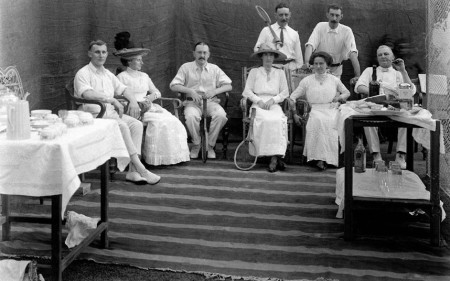
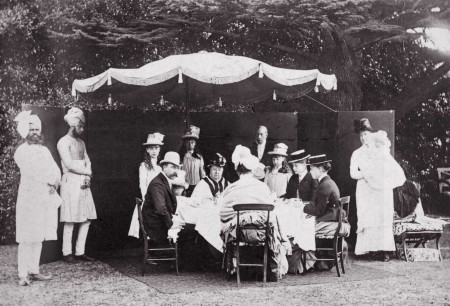 You can see some examples of Civil War-era knockdown furniture at this website.
You can see some examples of Civil War-era knockdown furniture at this website.
Jones, Robin D. Studies in the Decorative Arts 11.1 (2003): 137-39. Web.
Miller, Judith Furniture, page 180
Thomas Sheraton The cabinet dictionary. To which is added a supplementary treatise on geometrical lines, perspective, and painting in general 1803
The post Knockdown, Drag-Along appeared first on Sarah Albee.
May 27, 2016
Desk Jobs
I’ve been researching the late eighteenth and early nineteenth centuries, and I got curious about writing desks. They’ve evolved quite a bit over the past two hundred years, from this: To this:
To this: Yeah, that’s my treadmill desk. Not that my desk represents the most highly evolved of writing desks, but desks have definitely changed a lot.
Yeah, that’s my treadmill desk. Not that my desk represents the most highly evolved of writing desks, but desks have definitely changed a lot.
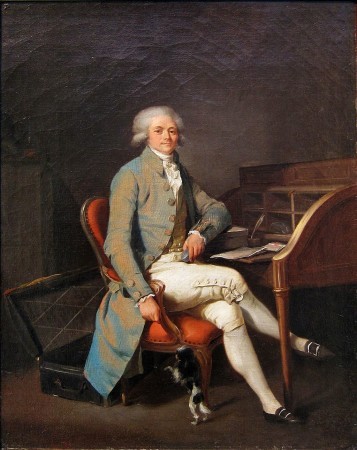
Robespierre at his desk.
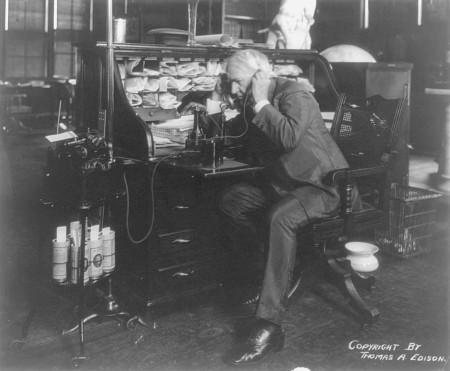
Edison at HIS desk.
What had me flummoxed me was how often I was seeing references to Enlightenment-era writers taking their writing desks along with them wherever they went.
Alexander Hamilton and George Washington brought theirs along to every campaign throughout the American Revolution. Lewis and Clark lugged theirs across the rugged Louisiana territory, over the Rockies, and all the way to the Pacific Ocean. And then there was the ill-fated Franklin expedition.
In 1845, British explorer and nineteenth century celebrity John Franklin set off from England across the Atlantic Ocean with two ships, 129 officers and crew, and enough food for three years. Their mission was to find a northwest route to Asia by sailing around the top of Canada. Many Europeans eagerly awaited their news. A few months after setting sail, the expedition vanished.
A major search effort was organized. Little by little, a few clues were revealed. Eventually the remains of twenty-five sailors were recovered. They’d been pulling a lifeboat across the icy terrain on ropes, hoping to reach mainland Canada. In the boat were strange items like button polish, curtain rods, and…a writing desk. Not exactly what you’d expect to find in an Arctic survival kit. The exact fate of the Franklin expedition remains a mystery, but a plausible theory is they developed severe lead poisoning from their lead-soldered cans of provisions.
Anyway, it turns out, the writing desks that all of these guys brought with them were the traveling kind. They looked like this:
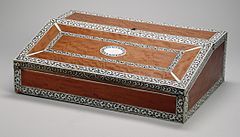
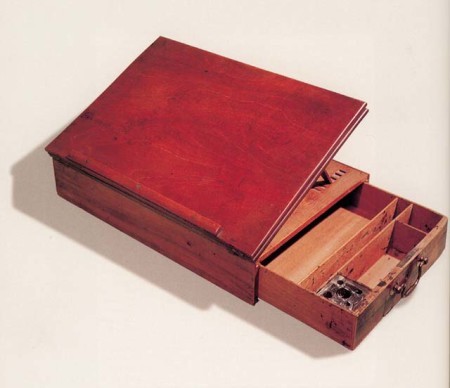
This is Thomas Jefferson’s desk.
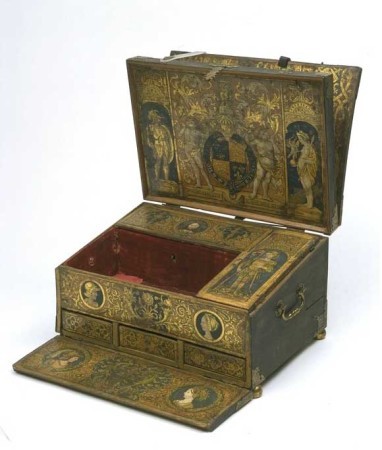
Henry VIII’s writing desk. Not known for his moderation.
The first laptops.
The post Desk Jobs appeared first on Sarah Albee.



